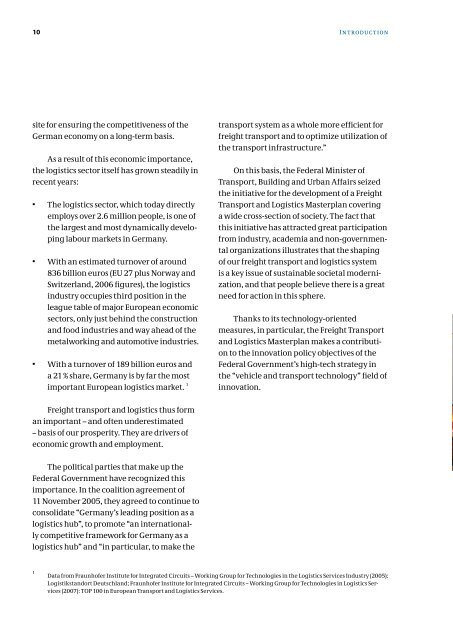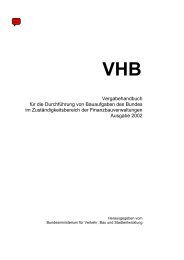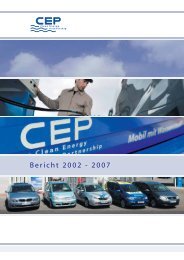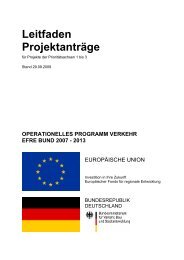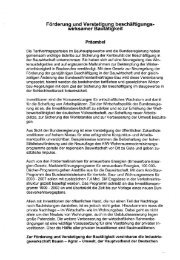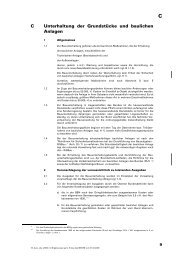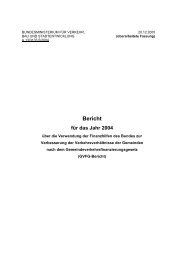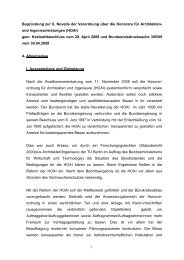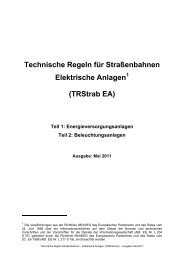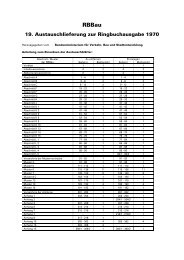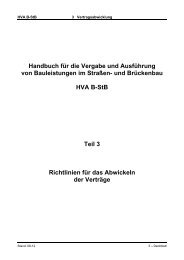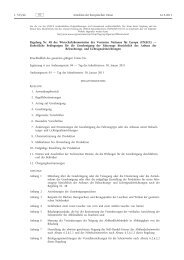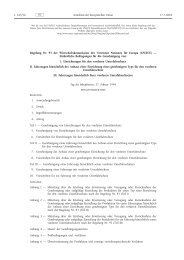Freight Transport and Logistics Masterplan - Bundesministerium für ...
Freight Transport and Logistics Masterplan - Bundesministerium für ...
Freight Transport and Logistics Masterplan - Bundesministerium für ...
Create successful ePaper yourself
Turn your PDF publications into a flip-book with our unique Google optimized e-Paper software.
10 Introduction Introduction 11<br />
site for ensuring the competitiveness of the<br />
German economy on a long-term basis.<br />
As a result of this economic importance,<br />
the logistics sector itself has grown steadily in<br />
recent years:<br />
• The logistics sector, which today directly<br />
employs over 2.6 million people, is one of<br />
the largest <strong>and</strong> most dynamically developing<br />
labour markets in Germany.<br />
• With an estimated turnover of around<br />
836 billion euros (EU 27 plus Norway <strong>and</strong><br />
Switzerl<strong>and</strong>, 2006 figures), the logistics<br />
industry occupies third position in the<br />
league table of major European economic<br />
sectors, only just behind the construction<br />
<strong>and</strong> food industries <strong>and</strong> way ahead of the<br />
metalworking <strong>and</strong> automotive industries.<br />
• With a turnover of 189 billion euros <strong>and</strong><br />
a 21 % share, Germany is by far the most<br />
important European logistics market. 1<br />
<strong>Freight</strong> transport <strong>and</strong> logistics thus form<br />
an important – <strong>and</strong> often underestimated<br />
– basis of our prosperity. They are drivers of<br />
economic growth <strong>and</strong> employment.<br />
The political parties that make up the<br />
Federal Government have recognized this<br />
importance. In the coalition agreement of<br />
11 November 2005, they agreed to continue to<br />
consolidate “Germany’s leading position as a<br />
logistics hub”, to promote “an internationally<br />
competitive framework for Germany as a<br />
logistics hub” <strong>and</strong> “in particular, to make the<br />
transport system as a whole more efficient for<br />
freight transport <strong>and</strong> to optimize utilization of<br />
the transport infrastructure.”<br />
On this basis, the Federal Minister of<br />
<strong>Transport</strong>, Building <strong>and</strong> Urban Affairs seized<br />
the initiative for the development of a <strong>Freight</strong><br />
<strong>Transport</strong> <strong>and</strong> <strong>Logistics</strong> <strong>Masterplan</strong> covering<br />
a wide cross-section of society. The fact that<br />
this initiative has attracted great participation<br />
from industry, academia <strong>and</strong> non-governmental<br />
organizations illustrates that the shaping<br />
of our freight transport <strong>and</strong> logistics system<br />
is a key issue of sustainable societal modernization,<br />
<strong>and</strong> that people believe there is a great<br />
need for action in this sphere.<br />
Thanks to its technology-oriented<br />
measures, in particular, the <strong>Freight</strong> <strong>Transport</strong><br />
<strong>and</strong> <strong>Logistics</strong> <strong>Masterplan</strong> makes a contribution<br />
to the innovation policy objectives of the<br />
Federal Government’s high-tech strategy in<br />
the “vehicle <strong>and</strong> transport technology” field of<br />
innovation.<br />
. <strong>Freight</strong> transport <strong>and</strong> logistics at the centre of social<br />
change – new challenges for transport policy<br />
Germany has one of the most modern<br />
transport infrastructures in the world, with a<br />
dense <strong>and</strong> efficient network of roads, railways,<br />
waterways, ports <strong>and</strong> airports. The logistics<br />
systems have been developed to a very high<br />
st<strong>and</strong>ard. The Federal Government’s objective<br />
is to lastingly secure the leading position<br />
that Germany enjoys in freight transport <strong>and</strong><br />
logistics <strong>and</strong> in transport infrastructure. To<br />
achieve this goal, both the public <strong>and</strong> private<br />
sectors have to address the economic, social<br />
<strong>and</strong> ecological challenges.<br />
a) Traffic growth as a result of globalization<br />
<strong>and</strong> an increasing division of labour<br />
The first <strong>and</strong>, at the same time, key challenge<br />
to which the Federal Government is<br />
responding with this <strong>Masterplan</strong> is the drastic<br />
rise in the level of freight traffic that is likely<br />
as a result of globalization <strong>and</strong> increasing<br />
division of labour in the economy. Increasing<br />
specialization <strong>and</strong> division of labour will lead<br />
to a further rise in international trade. The<br />
result will be that more <strong>and</strong> more goods are<br />
transported over increasingly long distances.<br />
This means that there is likely to be a sharp increase<br />
in the dem<strong>and</strong> for logistics <strong>and</strong> freight<br />
transport services.<br />
If we do not react to this, the result will be<br />
that tonne-kilometres in Germany are likely<br />
to rise by 71 % between 2004 <strong>and</strong> 2025. In the<br />
road haulage sector, this rise will be higher<br />
(79 %) <strong>and</strong> in long-distance road haulage it<br />
will be as high as 84 % . 2 Moreover, since this<br />
rise will differ from one region to the next, it is<br />
likely that freight traffic levels will almost double<br />
on some trunk roads. If this forecast rise<br />
were to become reality, it would mean: where<br />
today one lane of a motorway is used by heavy<br />
goods vehicles, in just under twenty years two<br />
lanes would be necessary to cope with the<br />
increased volume of freight traffic. In addition,<br />
passenger traffic will also increase, although<br />
at a much lower rate (19 %).<br />
It is obvious that such growth presents<br />
transport policymakers with great challenges.<br />
They have to ensure that economic growth<br />
<strong>and</strong> jobs, on which we depend to secure our<br />
prosperity, are not constricted by bottlenecks<br />
in the transport system. Inadequate transport<br />
1<br />
Data from Fraunhofer Institute for Integrated Circuits – Working Group for Technologies in the <strong>Logistics</strong> Services Industry (2005):<br />
2<br />
Intraplan Consult GmbH <strong>and</strong> BVU Beratergruppe Verkehr + Umwelt GmbH (2007): Prognose der deutschl<strong>and</strong>weiten Verkehrsver-<br />
Logistikst<strong>and</strong>ort Deutschl<strong>and</strong>; Fraunhofer Institute for Integrated Circuits – Working Group for Technologies in <strong>Logistics</strong> Services<br />
(2007): TOP 100 in European <strong>Transport</strong> <strong>and</strong> <strong>Logistics</strong> Services.<br />
flechtungen 2025, R&D No 96.0857/2005, commissioned by the Federal Ministry of <strong>Transport</strong>, Building <strong>and</strong> Urban Affairs.


